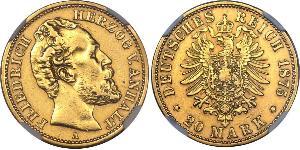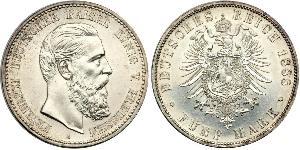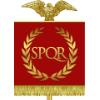20 Mark Kingdom of Prussia (1701-1918) Gold Wilhelm I, German Emp ...
GERMANY, Prussia, Wilhelm I, twenty mark 1876A (KM.505).
72
coins in the group
View all coins in the group
View all coins in the group
(1537 X 731pixels, file size: ~252K)
Posted by: anonymous 2018-11-30
CoinWorldTV 1879, Prussia/German Empire, Wilhelm "the Great". Gold 20 Mark Coin. 7.97gm! Mint Year: 1879 Reference: KM-505. Mint Place: Berlin (A) Condition: Numerous circulation-marks and light deposits, otherwise XF-AU! Material: Gold (.900) Diameter: 22mm Weight: 7.97gm Obverse: He ...
(1500 X 746pixels, file size: ~216K)
Posted by: anonymous 2018-03-30
Preußen. Wilhelm I. 1861-1888. 20 Mark 1887 A. Jaeger 246.GOLD. Kleiner Randfehler, winzige Kratzer, sehr schön - vorzüglich
(1500 X 748pixels, file size: ~218K)
Posted by: anonymous 2018-03-30
Preußen. Wilhelm I. 1861-1888. 20 Mark 1875 A. Jaeger 243.GOLD. Winziger Randfehler, winzige Kratzer, fast vorzüglich
(1500 X 758pixels, file size: ~215K)
Posted by: anonymous 2017-12-15
Preußen, Wilhelm I.20 Mark 1878 A. Jaeger 246. GOLD. Winzige Kratzer, sehr schön +
(900 X 452pixels, file size: ~130K)
Posted by: anonymous 2017-04-02
Preußen, Wilhelm I.20 Mark 1888 A. Jaeger 246. GOLD. Winziger Randfehler, vorzüglich
(900 X 453pixels, file size: ~132K)
Posted by: anonymous 2017-04-02
Preußen, Wilhelm I.20 Mark 1887 A. Jaeger 246. GOLD. Sehr schön - vorzüglich
Related online coin collections

dpa1 » Wilhelm I "the Great", first ... (9 coins)
Wilhelm I, also known as Wilhelm "the Great" (1797 – 1888) of the House of Hohenzollern was the King of Prussia (January 2, 1861 – 9 March, 1888) and the first German Emperor (18 January 1871 – 9 March, 1888). Under the leadership of Wilhelm and ...
Articles
|
You may be interested in following coins
2024-04-26
- Historical Coin Prices
2024-04-26
- New coin is added to 1000 Escudo Portuguese Republic (1975 - ) Silver
1000 Escudo Portuguese Republic (1975 - ) Silver
group has 4 coins / 2 prices
⇑
1996, Portugal. Silver 1000 Escudos "Ferdinand II & Gloria Frigate" Coin. 28gm! Mint Year: 1996 Reference: KM-688. Condition: UNCirculated! Denomination: 1000 Escudos - Restoration ...
You may be interested in ...

-500-250-6C0KbzbiS_UAAAFL2EoTtaP7.jpg)
-300-150-bkO8ZsvESlgAAAFnIqbuVGM0.jpg)
-300-150-iKoKqUpYdNgAAAFiObas73je.jpg)
-300-150-qW8KqUpY6IUAAAFipw6s73jd.jpg)
-300-150-bEYKqUpYge4AAAFgzp08PlgO.jpg)
-300-150-MfMKX9ISlEsAAAFb10Yqmi1q.jpg)
-300-150-2ucKX9IS66kAAAFbiiwqmi1q.jpg)







-300-150-4_rBwcI0KHUAAAErA3CtcqZ1.jpg)






